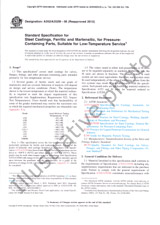We need your consent to use the individual data so that you can see information about your interests, among other things. Click "OK" to give your consent.
ASTM E2227-23
Standard Guide for Forensic Examination of Dyes in Textile Fibers by Thin-Layer Chromatography
Translate name
STANDARD published on 1.5.2023
The information about the standard:
Designation standards: ASTM E2227-23
Note: WITHDRAWN
Publication date standards: 1.5.2023
SKU: NS-1144158
The number of pages: 9
Approximate weight : 27 g (0.06 lbs)
Country: American technical standard
Category: Technical standards ASTM
Annotation of standard text ASTM E2227-23 :
Keywords:
fibers, forensic science, thin-layer chromatography,, ICS Number Code 07.140 (Forensic science),71.040.50 (Physicochemical methods of analysis)
Additional information
| Significance and Use | ||||||||
|
5.1?TLC is an inexpensive and simple technique that could be used to complement other analytical techniques within a general analytical scheme related to forensic fiber examination. 5.2?Consider the forensic analysis of fiber colorants using TLC for single fiber comparisons only when the sample size is adequate (that is, enough colorant can be extracted for analysis) and it is not possible to discriminate between the fibers of interest using other techniques, such as comparison microscopy and MSP. Larger fibrous units (for example, thread or tuft) can be treated as an individual sample if determined to be homogeneous. Do not treat fibers that cannot be directly related to each other as a collective sample for the purposes of TLC. 5.3?The extraction procedures carried out prior to TLC analysis can provide useful information about dye classification. TLC can provide qualitative information about dye components. Similar colors made up of different dye components can be differentiated using this technique. The application of TLC may serve to discriminate between fibers or it may support the possibility of fibers sharing a common source. 5.4 TLC can be prohibitively difficult or undesirable in some circumstances. Short lengths of fibers or pale-colored fibers can lack adequate amounts of colorant necessary to be examined by TLC. Dye extraction from some fibers can be impossible (2, 3). Some fiber types do not truly extract, but change or lose color. Reactive dyes are covalently bonded to the fiber and typically cannot be removed by conventional extraction methods, but can be released from cotton and wool by disrupting the fiber by enzymatic or chemical digestion, respectively 1.1?This guide is intended as an overview of the Thin-Layer Chromatography (TLC) of fiber colorants (or individual dye components) present in dyed fibers. It is intended to be applied within the scope of a broader analytical scheme for the forensic analysis of fiber samples. TLC could provide information that cannot be obtained through other color analyses (such as microspectrophotometry (MSP)) 1.2?This standard is intended for use by competent forensic science practitioners with the requisite formal education, discipline-specific training (see Practice E2917), and demonstrated proficiency to perform forensic casework (see Practice E3255). 1.3?The values stated in SI units are to be regarded as standard. No other units of measurement are included in this standard. 1.4?This standard does not purport to address all of the safety concerns, if any, associated with its use. It is the responsibility of the user of this standard to establish appropriate safety, health, and environmental practices and determine the applicability of regulatory limitations prior to use. 1.5?This international standard was developed in accordance with internationally recognized principles on standardization established in the Decision on Principles for the Development of International Standards, Guides and Recommendations issued by the World Trade Organization Technical Barriers to Trade (TBT) Committee. |
||||||||
| 2. Referenced Documents | ||||||||
|
We recommend:
Updating of laws
Do you want to be sure about the validity of used regulations?
We offer you a solution so that you could use valid and updated legislative regulations.
Would you like to get more information? Look at this page.




 Cookies
Cookies
